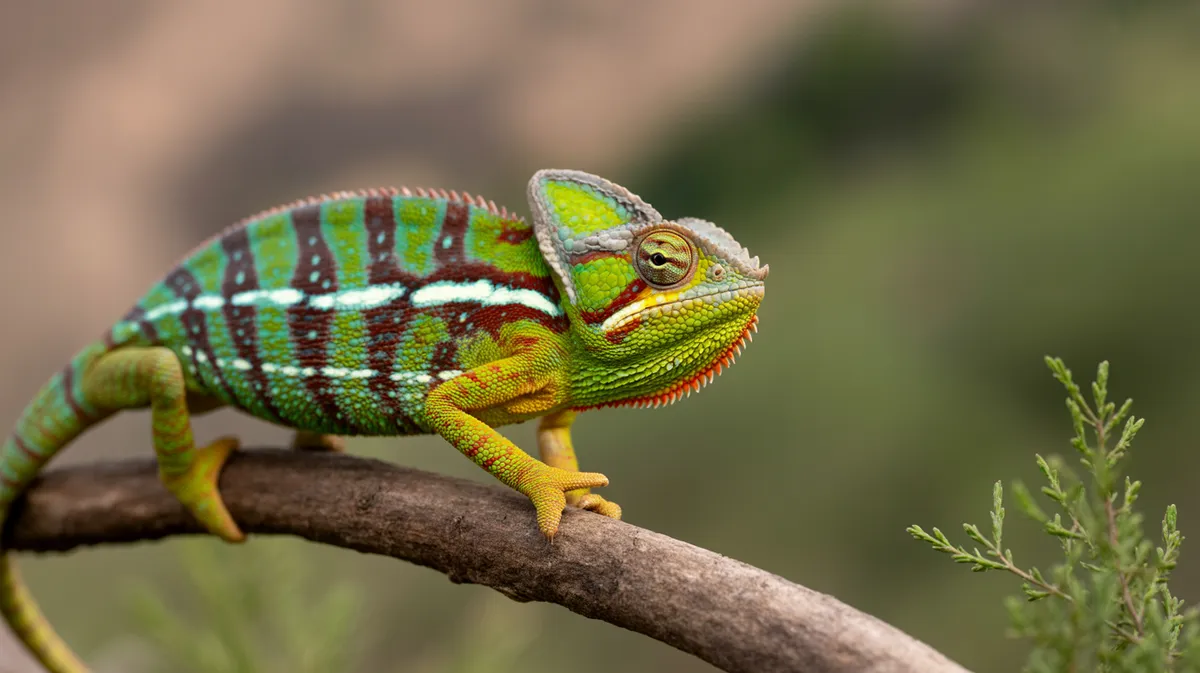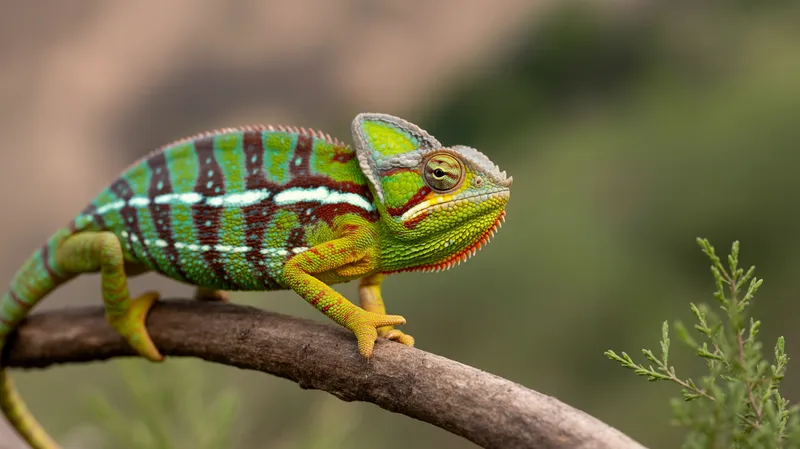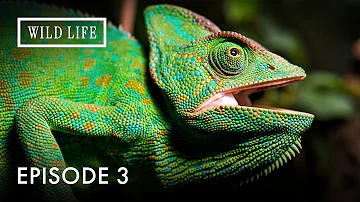
Yemen Chameleon
Chamaeleo calyptratus

Meet the Yemen Chameleon
The Yemen Chameleon, also known as the Veiled Chameleon, is a striking arboreal reptile native to the Arabian Peninsula. It is renowned for its vibrant coloration, tall casque (crest) atop its head, and independently moving eyes. This species exhibits pronounced sexual dimorphism, with males being larger and more vividly colored than females. Yemen Chameleons are skilled climbers and are primarily found in trees and bushes within their native range.
Classification
Reptile
Habitat
Mountain forests and semi-arid regions with vegetation
Diet
Omnivore
Lifespan
5-8 years
Conservation
Least Concern
Weight
85-180 grams
📖Fascinating Facts
Independent Eyes
Each of the Yemen Chameleon’s eyes can rotate separately, giving it a full 360-degree field of vision to spot predators and prey.
Color Changing
This chameleon changes its skin color depending on mood, temperature, and social signals, not just for camouflage.
Impressive Casque
The tall casque atop the chameleon's head helps with water collection and may serve as a visual signal to other chameleons.
📋Detailed Description
The Yemen Chameleon (Chamaeleo calyptratus), also known as the Veiled Chameleon, is a medium-to-large arboreal lizard, with adult males typically reaching 43–61 cm (17–24 in) in total length, while females are smaller, averaging 30–35 cm (12–14 in). Its most distinctive feature is the prominent casque, or helmet-like crest, atop the head, which can reach up to 5 cm (2 in) in height in mature males and serves both for sexual display and water collection. The body is laterally compressed, aiding in camouflage among branches, and covered in granular scales. Coloration is highly variable and can include shades of green, yellow, turquoise, and brown, with males displaying more vivid patterns and females often exhibiting mottled or banded coloration, especially during breeding. The chameleon's zygodactylous feet and prehensile tail provide exceptional grip for navigating complex vegetation. Eyes move independently, granting a 360-degree field of vision, crucial for spotting prey and predators. The tongue is highly specialized, capable of rapidly projecting up to twice the body length to capture insects. Yemen Chameleons are primarily diurnal and solitary, with pronounced territoriality, especially among males. Their ability to change color is used for communication, thermoregulation, and camouflage rather than solely for blending into their environment. In their native range, they inhabit a variety of habitats from humid mountain slopes to arid plateaus, provided there is sufficient vegetation for cover and hunting.
💡 Did you know?
A Yemen Chameleon’s tongue can extend up to twice the length of its body to catch prey with incredible speed and accuracy.
🔬Research & Sources
Wikipedia Summary
The veiled chameleon is a species of chameleon native to the Arabian Peninsula in Yemen and Saudi Arabia. Other common names include cone-head chameleon, Yemen chameleon, and Yemeni chameleon. They are born pastel green and without their distinctive casques on their head.
Last Modified: 5/26/2025
🎭Behavior & Social Structure
Yemen Chameleons are solitary and highly territorial, with males displaying aggressive postures, color changes, and head-bobbing to deter rivals. They are sit-and-wait (ambush) predators, relying on their cryptic coloration and stillness to avoid detection while scanning for prey with their independently mobile eyes. Their diet is primarily insectivorous, consisting of crickets, locusts, and other arthropods, but they also consume plant matter, including leaves, flowers, and fruit, especially during dry periods. Hunting involves a rapid extension of the sticky, muscular tongue to snare prey at distances up to twice their body length. They are most active during daylight hours, basking in the morning to raise body temperature and seeking shade during the hottest part of the day. Social interactions are limited to brief encounters during the breeding season, with both sexes displaying a range of color patterns to signal receptivity or aggression. At night, they sleep on exposed branches, often turning pale to blend in with moonlit foliage.
👶Reproduction & Life Cycle
Veiled Chameleons are oviparous, with breeding typically triggered by seasonal rains in their native habitat. Courtship involves males displaying vibrant colors and performing head-bobbing and lateral body flattening to attract females. If receptive, the female signals by changing color and allowing copulation. Females lay between 20 and 80 eggs per clutch, with clutch size correlated to female size and nutritional status. Eggs are deposited in shallow nests dug in moist soil or leaf litter. Incubation lasts 150–200 days at optimal temperatures (24–29°C/75–84°F). There is no parental care; hatchlings are fully independent and begin feeding and climbing immediately after emergence. Females can produce multiple clutches per year, especially in captivity, but frequent breeding can lead to health issues such as egg-binding and metabolic bone disease.
🛡️Adaptations & Survival
Chamaeleo calyptratus exhibits several remarkable adaptations for arboreal life. The prehensile tail and zygodactylous feet (two toes forward, three backward) allow for secure grasping of branches. The large casque not only serves as a display structure but also helps direct dew and rainwater toward the mouth, aiding hydration in arid environments. Their unique eyes can rotate independently, providing nearly panoramic vision and depth perception essential for hunting and predator avoidance. The projectile tongue, powered by specialized accelerator muscles and elastic collagen, enables rapid prey capture at a distance. Color change is mediated by chromatophores and is used for communication, thermoregulation, and camouflage. Their skin is tough and granular, reducing water loss and providing some protection from predators and rough vegetation.
📚Research Sources
🎨Cultural Significance
In their native range, Yemen Chameleons are sometimes regarded with curiosity or superstition, but they do not hold significant roles in local mythology or traditional medicine. Globally, they are popular in the exotic pet trade due to their striking appearance and unique behaviors, which has contributed to their spread as an introduced species in places like Florida and Hawaii. Their remarkable color-changing ability has made them symbols of adaptability and transformation in popular culture.
🔬Recent Research & Discoveries
Recent research has focused on the biomechanics of chameleon tongue projection, revealing one of the fastest and most powerful muscle actions among vertebrates. Studies on color change have elucidated the role of structural iridophores in rapid shifts in skin coloration. Genetic studies are ongoing to clarify the evolutionary relationships within the Chamaeleonidae family. Ecological research in Yemen and Saudi Arabia has documented their adaptability to disturbed habitats and the importance of microhabitat structure for survival. Captive breeding programs have provided insights into reproductive physiology and the impacts of diet and husbandry on health and longevity.
🎥Wildlife Videos

Wildlife Instincts: Chameleons - Designed to Hunt | Free Documentary Nature
Wildlife Instincts - Episode 4: Chameleons - Designed to Hunt | Free Documentary Nature Watch "Wildlife Instincts: A Family Bond ...
Free Documentary - Nature

Beautiful Footage: Chameleons Are Amazing | National Geographic
About National Geographic: National Geographic is the world's premium destination for science, exploration, and adventure.
National Geographic

Nature's Masters of Disguise Chameleon Wonders in 4k!
Explore the captivating world of chameleons in this in-depth documentary, unveiling the secrets of these masters of disguise.
EAGLE CAM

The Enigmatic World of Chameleons | Wildlife Documentary | Fusion Documentary
The Enigmatic World of Chameleons | Wildlife Documentary | Fusion Documentary.
Fusion Documentary

Chameleon The Wild Animal - Animal Planet - Nature Documentary HD
Chameleons or chamaeleons (family Chamaeleonidae) are a distinctive and highly specialized clade of old world lizards with 202 ...
Nature Documentary HD

Color, Mystery, and Mastery – The Chameleon’s Wild Life | Chameleons Of The World | Episode 3
Chameleons Of The World These mysterious dwarf-like lions are known all over the world, but curiously can live only in very ...
Wild Life Documentary
🌍Habitat Information
The Yemen Chameleon typically inhabits Mountain forests and semi-arid regions with vegetation environments. Yemen Chameleons have adapted to their environments with specialized features and behaviors.
Primary Habitat:
Mountain forests and semi-arid regions with vegetation
More detailed habitat information will be available soon.
🛡️Conservation Status
The Yemen Chameleon is currently classified as Least Concern. Conservation efforts are crucial for preserving this species for future generations.
Common Threats:
- 🏠Habitat loss and fragmentation
- 🌡️Climate change impacts
- 🎯Hunting and poaching
- 🏭Human-wildlife conflict
⚠️Threats & Conservation Challenges
While currently listed as Least Concern by the IUCN, Yemen Chameleons face several localized threats. Habitat degradation due to agricultural expansion, overgrazing, and urbanization in Yemen and Saudi Arabia reduces available arboreal habitat. Collection for the international pet trade has led to population declines in some areas, though captive breeding has reduced wild-caught exports. Climate change poses a long-term threat by altering rainfall patterns and vegetation cover. Invasive species and predation by birds and snakes also impact populations. Despite these pressures, the species remains widespread and adaptable, but ongoing monitoring is recommended.
🔬Scientific Classification
Scientific Name
Chamaeleo calyptratus
Classification Hierarchy
🔍 About Taxonomic Classification
Taxonomic classification is a hierarchical system used by scientists to classify and organize living organisms based on shared characteristics and evolutionary relationships.
The system moves from broad categories (Kingdom) to increasingly specific ones, with each animal's scientific name typically consisting of its Genus and species.
📝Community Notes
Share your observations and insights about the Yemen Chameleon with our community of wildlife enthusiasts.
Join Our Community
Sign in to share your observations and connect with fellow wildlife enthusiasts.
Sign In to ContributeNo community notes yet
Be the first to share your observations about the Yemen Chameleon!
Explore Yemen Chameleon
Select a tab above to learn more about this amazing animal.
📸Photo Gallery
No photos available for this animal yet.
🌟Discover More Wildlife
Continue your journey of discovery with more fascinating animals from our database
